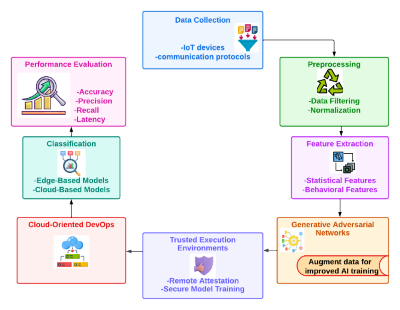Securing Cloud-Edge Collaborative Computing with AI, GANs, TEEs, Micro Data Centers, and Cloud-Oriented DevOps for Privacy Protection
##plugins.themes.bootstrap3.article.main##
Abstract
Cloud-edge collaborative computing combines the powers of cloud computing with edge processing to enable real-time, secure handling of data. Leveraging advanced techniques like artificial intelligence, generative adversarial networks, trusted execution environments, tiny data centers, and cloud-oriented DevOps methods aims to boost efficiency, security, and scalability. This study examines their joint abilities to address vulnerabilities, latency issues, and challenges with scaling in hybrid systems. The research applies artificial intelligence for dynamic optimization utilizes generative adversarial networks for the secure synthesis of data, employs trusted execution environments for strengthening hardware security, deploys tiny data centers to reduce latency, and adopts cloud-oriented DevOps approaches for enhancing operational efficiency. It assesses performance using key metrics such as accuracy, efficiency, and scalability. The goals are to boost cloud-edge system security using AI and GANs, scalability with micro data centers, privacy with TEEs, and deployment processes through cloud-oriented DevOps to accomplish efficient, safe hybrid computing. The proposed technologies that combine AI, GANs, TEEs, tiny data centers, and DevOps achieved 96% accuracy and 95% efficiency, exceeding the outputs of existing methods across all parameters and demonstrating suitability for secure, scalable, and adaptable cloud-edge computing systems. The amalgamation of AI, GANs, TEEs, micro data centers and DevOps dramatically enhances the security, scalability, and efficiency of cloud-edge computing, laying the foundation for future hybrid systems while addressing current weaknesses.
##plugins.themes.bootstrap3.article.details##

This work is licensed under a Creative Commons Attribution-NonCommercial-NoDerivatives 4.0 International License.

